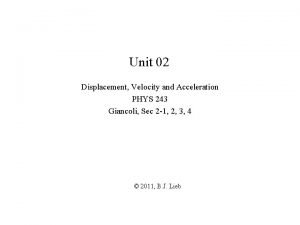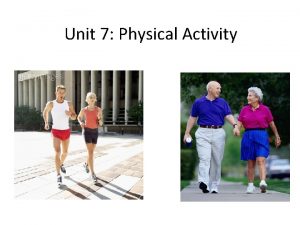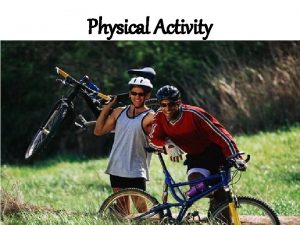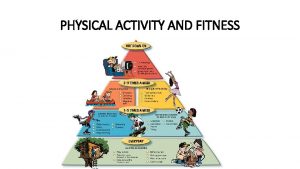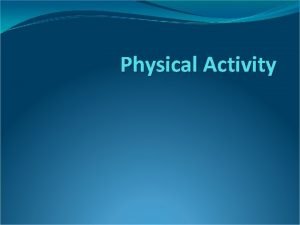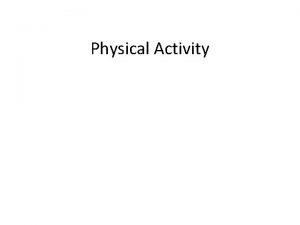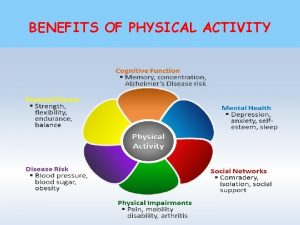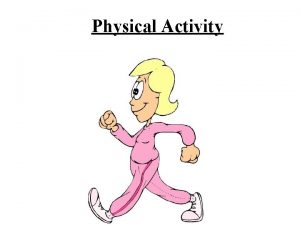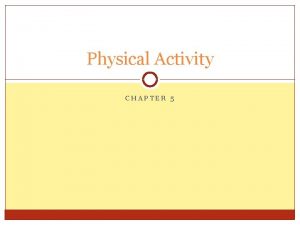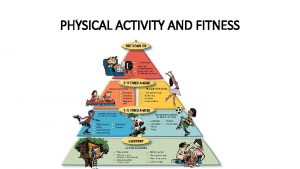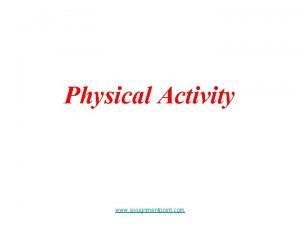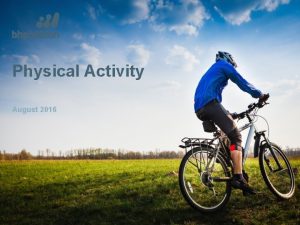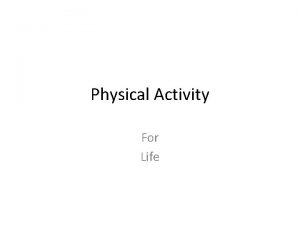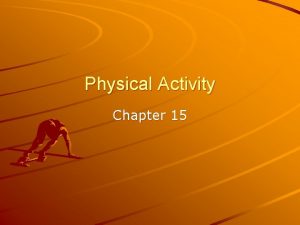Unit 7 Physical Activity The Average Canadian Physical


































- Slides: 34

Unit 7: Physical Activity

The Average Canadian?

Physical Activity in Canada • 63% of Candaians not getting enough physical activity to reap the associated health benefits • Most Candians are confused as to the PHAC facts recommendations for physcial activity

Canadian Health Measures Survey (CHMS, 2009) Change in PA of adults between 1981 -2007/2009

Canadian Health Measures Survey (CHMS, 2009) Change in PA of children between 1981 -2007/2009

Canadian Physical Activity Guide • Joint effort of Public Health Agency of Canada and Canadian society of Exercise Physiologists








Key definitions Physical Activity: any active movement you do that spends calories Exercise: is a planned, structured and repetitive activity aimed at improving physical fitness • Physical fitness: how able you are to perform physically demanding tasks The difference is your intentions!

Physical Activity http: //www. merthyr. gov. uk/Needs. Assessment/Health+and+Well -being/Physical+Activity. htm

Components of physical fitness • Health related fitness: has four components – Cardiorespiratory fitness – Muscular strength and endurance – Flexibility – Body weight and composition

Components of physical fitness • Performance-related fitness: includes the same as health-related PLUS: – Speed and power – Agility – Balance – Reaction time – Anaerobic power and capacity

Aerobic vs. Anaerobic Activity • There are two main ways that your body produces energy: – Aerobically (with oxygen): • C 6 H 12 O 6 + 6 O 2 → 6 H 2 O + 6 CO 2 + 38 ATP • Glucose + oxygen → water + carbon dioxide + ENERGY – Or Anaerobically (without oxygen) • C 6 H 12 O 6 → 2 C 3 H 6 O 3 + 2 ATP • Glucose → Lactic Acid + ENERGY

Aerobic fitness • • Uses aerobic metabolism Activities that train the cardiorespiratory system. Improves oxygen consumption in the body Performed at moderate intensities for extended periods of time – So your cardiovascular system knows exactly how much oxygen it needs to send and where to send it! • Raises heart rate, breathing rate, metabolic rate and body temperature

Recommended training zone In each session you should be working for 20 -60 minutes and at 60 -90 % of maximum heart rate Maximum HR (MHR)= 220 – your age in years = MHR X 0. 6 = 60% of your MHR X 0. 9 = 90% of your MHR To actually determine your heart rate, measure it at your pulse In a ten second interval, count the number of beats (start counting at one). Multiply that number by 6

Anaerobic Fitness • Use anaerobic metabolism • Intense activity that often improves strength power, speed, and muscle mass • These pathways are typically recruited – in the first 120 seconds of exercise – when exercise demand is increased – during short bouts of intense exercise

Risks of Physical Activity • Most common risk = injuries – Most often effect the musculoskeletal system – Traumatic injuries ex. Sprained ankle, fractured arm – – – Overuse injuries ex. Runner’s knee, tennis elbow General Overstress Temperature injury Dehydration Sudden death *****In people who are already at high risk****

Risks of Exercise • ***Overall, exercise reduces CVD risk. However, vigorous exercise increases risk of a myocardial infarction in people who already have CVD

Determining if you are overtraining • Exercise can become a compulsion: “I have to do it no matter what!” • Overtraining signs include: – Persistent pain, especially of the joints – Increased difficulty performing a standard exercise level – Increases susceptibility to infections. Ie. Influenza, acne – Feeling tired, lacking energy, lack of enthusiasm • If you are experiencing these signs: REST!!!!

Where to start? ? Have a doctor examine you before you begin exercising if you are over 35 or at high risk Have someone who specializes in exercise supervise you –Increase activity level GRADUALLY!!


Muscular Strength and Endurance • Strength: the ability to produce a large amount of force in a single contraction • Endurance: the ability to perform many repetitions with a sub-maximal resistance

Muscular Strength and Endurance: Recommendations • balance both sides of your body • Do at least one exercise for each major muscle group • Do complimentary exercises – Ex. biceps curls after triceps extensions • • Do a full range of motion Work larger muscles first before smaller muscles Maintain correct technique Breathe!

Muscular Strength and Endurance: Recommendations • Overall, no single well-planned program is superior to another • Basic recommendation: – Moderate intensity resistance training – One set of 8 -12 exercises done at least 2 times per week – Schedule at least one day of rest between working the same muscle group – Mix it up to avoid boredom and plateaus!

Flexibility • Flexibility: the range of motion of a joint – Improves lifelong mobility, reduces risk of injury • Stretching is done to improve flexibility – Simplest stretching = static stretching • Muscles should be warm • Ease into the stretch (it should never hurt!) • Hold for at least 30 -60 seconds

Flexibility • Warming up should be done before performing any taxing exercise – Decreases risk of injury • This helps your body leave its homeostatic state and prepare itself for exercise • Then, gently stretch the muscle – Work your way through most joints

Yoga • Ancient practice, with many different manifestations • Has 8 main aspects: • breathing, postures, meditation, control of the senses, concentration, personal ethics, universal ethics and bliss • Several studies support the association between certain yoga practices and improved health

How does yoga produce health benefits? • Yoga downregulates the : – Hypothalamic-Pituitary-Adrenal (HPA) axis which leads to the release of cortisol, a stress hormone – Sympathetic nervous system (SNS), also elevated during stress response • These two systems are associated with increased risk of cardiovascular disease, obesity, diabetes, autoimmune disorders, depression, substance abuse, thus, yoga reduces their risk!

Meta-analysis of Yoga vs. Exercise
 Differentiate between average speed and average velocity
Differentiate between average speed and average velocity Physical activity and physical fitness assessments grade 9
Physical activity and physical fitness assessments grade 9 Unit 6 review questions
Unit 6 review questions Unit of average speed
Unit of average speed Hình ảnh bộ gõ cơ thể búng tay
Hình ảnh bộ gõ cơ thể búng tay Ng-html
Ng-html Bổ thể
Bổ thể Tỉ lệ cơ thể trẻ em
Tỉ lệ cơ thể trẻ em Gấu đi như thế nào
Gấu đi như thế nào Tư thế worm breton
Tư thế worm breton Hát lên người ơi alleluia
Hát lên người ơi alleluia Môn thể thao bắt đầu bằng chữ đua
Môn thể thao bắt đầu bằng chữ đua Thế nào là hệ số cao nhất
Thế nào là hệ số cao nhất Các châu lục và đại dương trên thế giới
Các châu lục và đại dương trên thế giới Cong thức tính động năng
Cong thức tính động năng Trời xanh đây là của chúng ta thể thơ
Trời xanh đây là của chúng ta thể thơ Mật thư anh em như thể tay chân
Mật thư anh em như thể tay chân 101012 bằng
101012 bằng Phản ứng thế ankan
Phản ứng thế ankan Các châu lục và đại dương trên thế giới
Các châu lục và đại dương trên thế giới Thơ thất ngôn tứ tuyệt đường luật
Thơ thất ngôn tứ tuyệt đường luật Quá trình desamine hóa có thể tạo ra
Quá trình desamine hóa có thể tạo ra Một số thể thơ truyền thống
Một số thể thơ truyền thống Cái miệng nó xinh thế
Cái miệng nó xinh thế Vẽ hình chiếu vuông góc của vật thể sau
Vẽ hình chiếu vuông góc của vật thể sau Thế nào là sự mỏi cơ
Thế nào là sự mỏi cơ đặc điểm cơ thể của người tối cổ
đặc điểm cơ thể của người tối cổ Thế nào là giọng cùng tên? *
Thế nào là giọng cùng tên? * Vẽ hình chiếu đứng bằng cạnh của vật thể
Vẽ hình chiếu đứng bằng cạnh của vật thể Phối cảnh
Phối cảnh Thẻ vin
Thẻ vin đại từ thay thế
đại từ thay thế điện thế nghỉ
điện thế nghỉ Tư thế ngồi viết
Tư thế ngồi viết Diễn thế sinh thái là
Diễn thế sinh thái là



